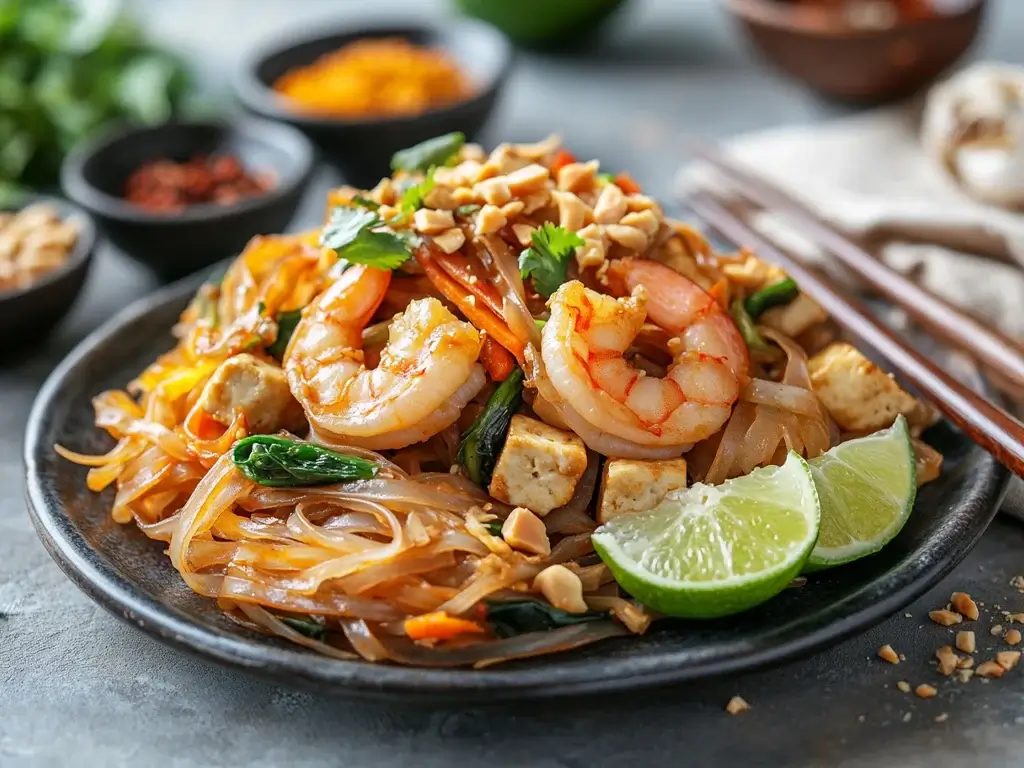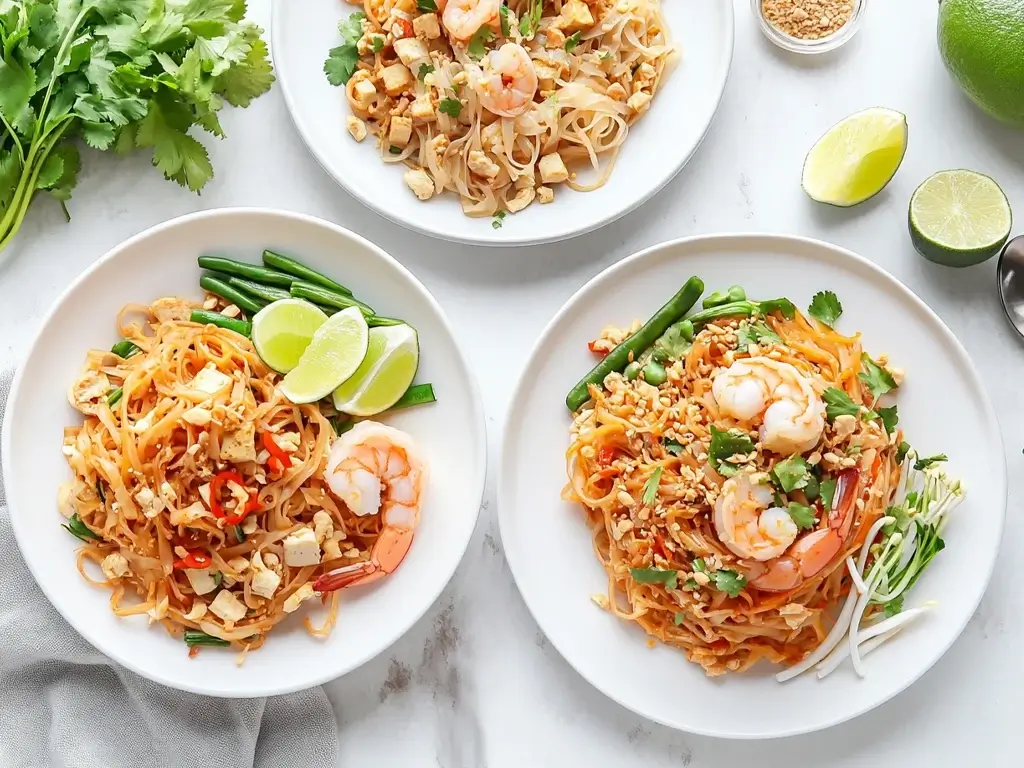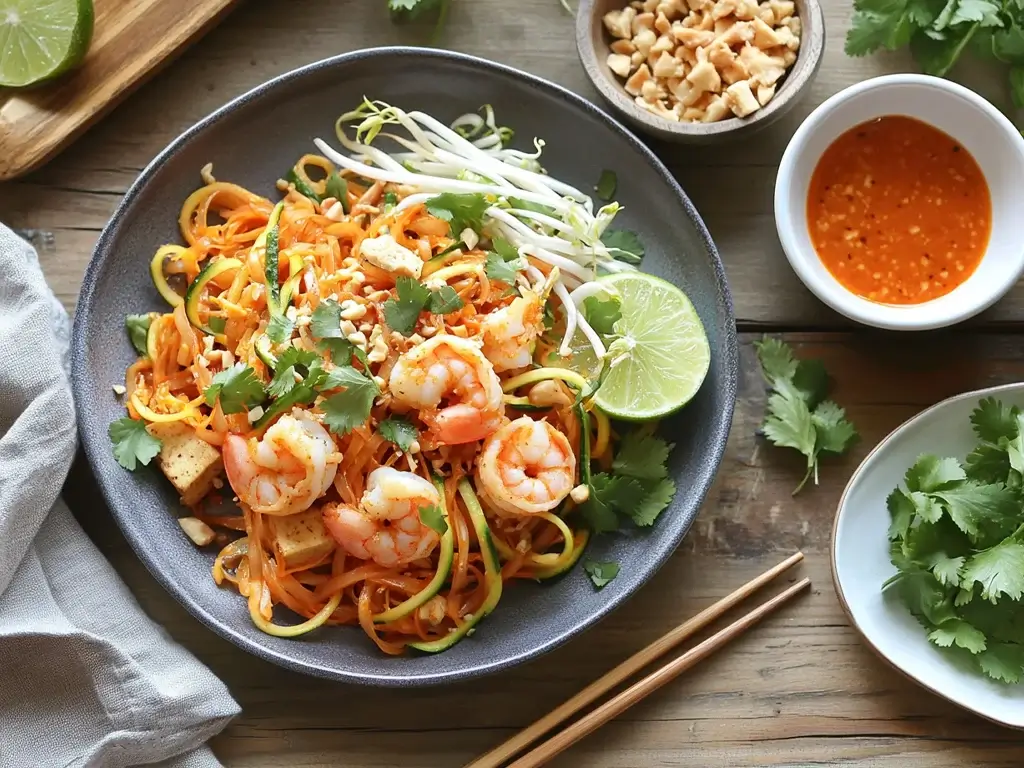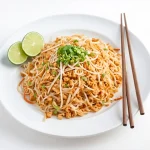Pad Thai is a beloved dish that has captured the hearts (and taste buds) of food enthusiasts worldwide. Its unique combination of flavors—a perfect harmony of sweet, savory, tangy, and umami—makes it a staple in Thai cuisine. But what truly sets Pad Thai apart is its versatility. Whether you’re enjoying it at a bustling street market in Bangkok or crafting it in your kitchen, it’s a dish that never fails to impress.
However, for those mindful of their nutritional intake, understanding the calorie content of Pad Thai is essential. Like many comfort foods, its calorie count can vary depending on the ingredients and preparation methods. This article dives into the intricate details of pad thai calories., exploring its nutritional aspects while celebrating its rich history and cultural significance. Whether you’re a health-conscious eater or simply curious about what makes this dish so irresistible, you’re in the right place.
Table of Contents
What Is Pad Thai?
A Brief History of Pad Thai
Pad Thai’s roots trace back to Thailand’s rich culinary traditions, with its origins steeped in both innovation and necessity. This iconic dish emerged in the 1930s and 1940s during a period of economic transformation under Prime Minister Plaek Phibunsongkhram. To promote national identity and reduce reliance on imported goods, the government encouraged the consumption of rice noodles, a locally sourced ingredient. Thus, Pad Thai was born—a creative fusion of traditional Thai flavors and accessible ingredients.
Over the decades, Pad Thai has evolved into a global sensation. While its core recipe remains intact, regional and personal variations have given it a dynamic edge, ensuring its enduring popularity. Despite its modern iterations, Pad Thai continues to reflect the cultural and historical essence of Thailand.
Traditional Ingredients in Pad Thai
At its heart, Pad Thai is a simple yet flavorful dish. The traditional recipe features flat rice noodles stir-fried with eggs, tofu, shrimp or chicken, and bean sprouts. A rich sauce made from tamarind paste, fish sauce, palm sugar, and lime juice brings the dish together, creating a delicate balance of flavors. Crushed peanuts and fresh lime wedges are typically added as garnishes, enhancing both texture and taste.
While these ingredients form the foundation of Pad Thai, their specific quantities and preparations can vary. The dish’s adaptability allows chefs and home cooks alike to experiment, incorporating additional elements like chili flakes, garlic chives, or pickled radish to suit personal preferences.
Variations in Ingredients and Their Impact
The beauty of Pad Thai lies in its adaptability. Modern variations cater to dietary restrictions and regional preferences, offering something for everyone. Vegetarian and vegan versions replace traditional proteins like shrimp or chicken with tofu or plant-based alternatives. Similarly, gluten-free adaptations swap standard soy sauce with tamari or coconut aminos.
These variations significantly impact the dish’s nutritional profile. For instance, using tofu instead of shrimp can lower calorie content while increasing plant-based protein. On the other hand, adding extra garnishes like peanuts or fried onions can elevate the calorie count. Cooking methods also play a role—stir-frying with less oil or opting for air-frying can reduce the overall caloric density without compromising flavor.
Whether you stick to the classic recipe or explore innovative twists, Pad Thai remains a flavorful and satisfying dish that’s adaptable to almost any palate or dietary goal. Its rich history and diverse ingredients make it a culinary treasure worth savoring and understanding.
Nutritional Breakdown of Pad Thai

Pad Thai is as rich in nutrition as it is in flavor. While it’s often enjoyed as a comfort food, understanding its nutritional composition can help you make informed dietary choices. This section breaks down the calorie content, macronutrient balance, and key vitamins and minerals that make up this iconic dish.
Calories in a Standard Serving
The calorie content of Pad Thai can vary significantly depending on portion size and preparation methods. On average, a standard serving of Pad Thai contains approximately 400 to 600 calories. Explore a detailed breakdown of Pad Thai’s nutritional content here.
A restaurant-made version may lean toward the higher end of the spectrum due to the generous use of oils, sauces, and garnishes.
For homemade versions, the calorie count can be more controlled. By adjusting ingredients like noodles, protein sources, and cooking oil, it’s possible to tailor the dish to align with specific dietary needs. For instance, using less oil and more vegetables can significantly reduce calorie density while maintaining flavor.
Macronutrient Composition
Protein, Fats, and Carbohydrates Explained
Pad Thai is a well-rounded dish that offers a balanced mix of macronutrients:
- Carbohydrates: The rice noodles form the primary carbohydrate source, contributing around 50 to 75 grams per serving. These carbohydrates provide energy and make the dish satisfying and hearty.
- Protein: Depending on the choice of protein, Pad Thai contains about 15 to 20 grams of protein per serving. Shrimp, chicken, or tofu are common options, each adding its unique nutritional profile.
- Fats: The fats in Pad Thai mainly come from cooking oils, eggs, and garnishes like crushed peanuts. A serving typically includes 10 to 15 grams of fat, which enhances the dish’s richness and mouthfeel.
This balance of macronutrients makes Pad Thai a filling meal that can suit various dietary goals, from muscle building to energy replenishment after physical activity.
Vitamins and Minerals in Pad Thai
Beyond its macronutrients, Pad Thai is a valuable source of essential vitamins and minerals. The inclusion of fresh ingredients like tamarind, lime, and bean sprouts boosts its nutritional profile:
- Vitamin C: Lime juice and bean sprouts contribute vitamin C, which supports the immune system and promotes healthy skin.
- B Vitamins: Eggs and tamarind paste provide B-complex vitamins, including B1 (thiamine) and B2 (riboflavin), crucial for energy metabolism.
- Iron and Calcium: Tofu and shrimp offer iron for red blood cell production and calcium for strong bones and teeth.
- Potassium: Bean sprouts and tamarind add potassium, essential for maintaining fluid balance and healthy muscle function.
The diversity of ingredients in Pad Thai ensures it’s not just delicious but also nutrient-dense. By adjusting portion sizes and ingredient choices, you can enjoy this dish in a way that aligns with your health goals while still savoring its signature flavors.
Caloric Differences Based on Variations

One of the most fascinating aspects of Pad Thai is its adaptability. The calorie content can vary significantly based on the ingredients and preparation methods, making it a versatile dish for various dietary preferences and goals. Let’s explore how these variations impact the overall caloric value of this beloved meal.
Meat-Based vs. Vegetarian Pad Thai
The choice between meat-based and vegetarian Pad Thai can have a notable effect on calorie content:
- Meat-Based Pad Thai: Traditional versions often include proteins like shrimp, chicken, or pork. These proteins add flavor and essential nutrients like protein, iron, and B vitamins, but they also influence the calorie count. For instance, chicken or shrimp Pad Thai typically ranges between 400 and 600 calories per serving, depending on portion size and cooking methods.
- Vegetarian Pad Thai: Vegetarian versions use tofu, eggs, or extra vegetables as the primary protein sources. Tofu provides plant-based protein with fewer calories than most meats. A vegetarian Pad Thai may clock in at 350 to 500 calories per serving, depending on the amount of oil and other ingredients used.
Swapping meat for vegetarian options can lower the calorie count while still offering a nutritious and satisfying meal. Additionally, opting for extra vegetables boosts fiber content, which helps with satiety and overall health.
Impact of Cooking Oils and Sauces
Cooking oils and sauces play a significant role in the calorie content of Pad Thai:
- Cooking Oils: Stir-frying with generous amounts of oil can add hundreds of calories. Using lighter options like avocado or olive oil in moderation can reduce the calorie load without compromising flavor.
- Sauces: The sauce is a key element of Pad Thai, combining tamarind paste, fish sauce, palm sugar, and lime juice. While these ingredients are essential for flavor, their quantities can dramatically affect the calorie count. For instance, palm sugar adds sweetness but also increases calorie density. Opting for reduced amounts of sugar or using natural sweeteners like stevia can help lower the caloric impact.
Balancing these elements allows for customization—you can enjoy a flavorful Pad Thai without unnecessary calories.
Gluten-Free or Low-Carb Pad Thai Alternatives
For those following gluten-free or low-carb diets, there are excellent alternatives to traditional Pad Thai that maintain its signature taste:
- Gluten-Free Options: Substituting standard soy sauce with tamari or coconut aminos ensures the dish remains gluten-free. Rice noodles are naturally gluten-free, but for extra assurance, verify packaging for cross-contamination warnings.
- Low-Carb Alternatives: Replacing rice noodles with spiralized zucchini (zoodles), shirataki noodles, or spaghetti squash dramatically reduces carbohydrate and calorie content. These options provide similar textures while cutting calories by more than half compared to traditional rice noodles.
By making mindful ingredient swaps, you can create a Pad Thai that aligns with specific dietary needs, whether you’re managing calorie intake, following a gluten-free diet, or reducing carbs. These variations ensure everyone can enjoy this iconic dish without sacrificing flavor or nutritional value.
Pad Thai and Dietary Goals

Pad Thai can be both a delicious indulgence and a nutritious meal, depending on how it’s prepared. Whether you’re aiming to lose weight, maintain a balanced diet, or customize your meals for specific health goals, Pad Thai offers a versatile canvas for dietary adjustments. Here’s how you can align this iconic dish with your personal health objectives.
Is Pad Thai Suitable for Weight Loss?
The suitability of Pad Thai for weight loss largely depends on portion control and ingredient choices. A typical restaurant serving can range from 500 to 800 calories, which might be high for those on a calorie-restricted diet. However, with mindful modifications, Pad Thai can fit well into a weight-loss plan:
- Control Portions: Opt for smaller servings to manage calorie intake without sacrificing taste.
- Add More Vegetables: Increasing the vegetable-to-noodle ratio can bulk up the dish, making it more filling while reducing calories per bite.
- Lean Protein Choices: Use shrimp, chicken breast, or tofu instead of higher-calorie protein options like pork or fried proteins.
- Limit Sauces and Oils: Request lighter sauces and minimal oil when dining out, or adjust these elements when cooking at home.
When prepared thoughtfully, Pad Thai can be a flavorful and satisfying dish that supports weight loss without feeling restrictive.
High-Calorie Additions to Avoid
Some ingredients and cooking techniques can significantly elevate the calorie count of Pad Thai. Here are a few elements to watch out for and minimize:
- Excess Oil: Stir-frying with too much oil can add hundreds of unnecessary calories. Use non-stick cookware or cooking sprays to cut down on oil usage.
- Sweetened Sauces: Palm sugar is a traditional component of Pad Thai sauce, but it’s calorie-dense. Consider reducing the sugar or substituting it with a natural sweetener like stevia or monk fruit.
- Generous Garnishes: While peanuts add flavor and texture, they’re calorie-rich. Use them sparingly or replace them with a sprinkle of sesame seeds for a lighter garnish.
- Fried Additions: Avoid fried proteins or crispy toppings like fried onions, which can add both fat and calories.
By avoiding or reducing these high-calorie components, you can enjoy Pad Thai with fewer worries about exceeding your calorie goals.
Customizing Pad Thai for Your Diet
The adaptability of Pad Thai makes it an excellent choice for customizing to various dietary needs. Here’s how you can tweak the dish to align with your goals:
- For Low-Carb Diets: Replace rice noodles with spiralized zucchini, shirataki noodles, or spaghetti squash to lower carbohydrate content. These alternatives are not only low in carbs but also significantly reduce the calorie count.
- For High-Protein Diets: Increase the portion of protein-rich ingredients like shrimp, chicken, or tofu while reducing the noodle content. This adjustment boosts protein intake while keeping calories in check.
- For Vegan or Vegetarian Diets: Skip animal-based proteins and add more tofu, tempeh, or a variety of vegetables. Use tamari instead of fish sauce to maintain the dish’s signature flavor while keeping it plant-based.
- For Low-Fat Diets: Use minimal oil for stir-frying and opt for lean proteins. Additionally, reduce or omit calorie-dense garnishes like peanuts or coconut milk.
Customizing Pad Thai ensures it can meet your specific dietary requirements without losing its signature taste. With a little creativity, this dish can transform into a nutritious and guilt-free meal tailored to your lifestyle.
How to Calculate Pad Thai Calories at Home
Understanding the calorie content of your Pad Thai at home is an empowering way to make healthier choices. By knowing exactly what goes into your dish, you can tailor it to meet your nutritional needs. Whether you’re tracking for weight loss or general health, calculating the calorie count of your homemade Pad Thai is easier than you might think.
Step-by-Step Guide to DIY Nutritional Analysis
Calculating the calories in your homemade Pad Thai involves breaking down the dish into its individual ingredients and understanding their nutritional values. Here’s a simple step-by-step guide:
- List All Ingredients: Begin by noting every ingredient you plan to use. Include rice noodles, protein (e.g., chicken, shrimp, or tofu), vegetables, cooking oils, sauces, and garnishes like peanuts.
- Measure Quantities: Accurately measure the amount of each ingredient. Use a kitchen scale for precision, especially for calorie-dense items like peanuts and cooking oil.
- Look Up Calorie Values: Use reliable sources such as nutrition labels, USDA databases, or trusted apps to find the calorie content per serving or gram of each ingredient.
- Calculate Individual Contributions: Multiply the quantity of each ingredient by its calorie content to determine its total contribution to the dish. For example, if 100 grams of rice noodles have 150 calories, and you’re using 200 grams, the total from noodles would be 300 calories.
- Add It All Up: Combine the calorie values of all ingredients to get the total calorie count for the entire dish.
- Determine Serving Size: Divide the total calories by the number of servings to calculate the calorie content per portion. For instance, if your dish totals 1,200 calories and you’re serving four portions, each serving would contain 300 calories.
By following these steps, you’ll gain a clearer understanding of your meal’s nutritional profile and can adjust ingredients as needed to align with your dietary goals.
Tools and Apps for Calorie Tracking
To make calorie tracking even more straightforward, there are several tools and apps available to simplify the process. Here are some of the most popular and user-friendly options:
- MyFitnessPal: One of the most widely used apps, MyFitnessPal has a comprehensive database of ingredients and dishes. You can input your recipe, and it will calculate the total calorie count for you.
- Cronometer: This app is excellent for tracking not only calories but also macronutrients, vitamins, and minerals. It’s ideal for those looking to monitor their overall nutritional intake.
- Lose It!: A simple and intuitive app that lets you scan barcodes, input custom recipes, and track your calorie goals.
- Kitchen Scales with Nutrition Tracking: Some modern kitchen scales come with built-in nutrition tracking features. These scales provide calorie and nutrient information for weighed ingredients, offering accuracy and convenience.
- USDA FoodData Central: For those who prefer a web-based tool, this database offers detailed nutritional information for a wide range of foods.
By combining these tools with the DIY steps above, you can take full control over the calorie content of your homemade Pad Thai. Not only does this ensure accuracy, but it also helps you make informed decisions about what goes into your meals, supporting a balanced and health-conscious lifestyle.
Frequently Asked Questions
Why is Pad Thai so high in calories?
Pad Thai is often high in calories due to its combination of calorie-dense ingredients. Traditional versions include rice noodles, cooking oil, palm sugar, and peanuts, all of which contribute significantly to the overall calorie count. Additionally, restaurant preparations may use larger portions and extra oil or sweetened sauces, further increasing the calorie total. However, by moderating these ingredients or choosing healthier substitutions, you can enjoy a lighter version of Pad Thai. Learn more
What’s the lowest calorie Thai food?
Some of the lowest-calorie Thai foods include Tom Yum soup, fresh spring rolls, and green papaya salad. These dishes are typically lower in calories because they emphasize fresh vegetables, lean proteins, and light, flavorful broths or dressings. Opting for grilled or steamed dishes over fried ones can also help reduce calorie intake when dining on Thai cuisine.
Can I eat Pad Thai while on a diet?
Yes, you can eat Pad Thai while on a diet, but it’s essential to manage portion sizes and ingredient choices. Opt for a smaller serving, increase the vegetable content, and choose lean proteins like shrimp or chicken breast. Additionally, reducing oil and sugar in the sauce can make the dish more diet-friendly.
How many calories are in a typical serving of Pad Thai?
A typical restaurant serving of Pad Thai contains between 500 and 800 calories, depending on portion size and ingredients. Homemade versions can be customized to contain fewer calories, often ranging from 300 to 600 calories per serving.
Is Pad Thai healthy?
Pad Thai can be a healthy meal when prepared with fresh, wholesome ingredients and balanced portions. It provides a good mix of carbohydrates, protein, and healthy fats. Adding plenty of vegetables and using minimal oil can enhance its nutritional profile while keeping it flavorful.
What’s the best way to reduce Pad Thai calories at home?
The best way to reduce Pad Thai calories at home is by making mindful substitutions. Use spiralized vegetables or shirataki noodles instead of rice noodles, opt for lean proteins like shrimp or tofu, and minimize the use of oil and sugar in the sauce. These changes can significantly lower the calorie count without sacrificing taste.
Conclusion
Pad Thai is a delicious and versatile dish that holds a special place in both Thai cuisine and global food culture. While its calorie content can vary widely based on ingredients and preparation methods, it’s possible to enjoy this meal as part of a balanced diet with a few mindful adjustments.
By understanding the nutritional components of Pad Thai and exploring ways to customize it to your dietary needs, you can savor its iconic flavors without guilt. Whether you’re dining out or cooking at home, knowledge is key to making better choices. From ingredient swaps to portion control, there are countless ways to make Pad Thai work for your health goals.
So, whether you’re indulging in its traditional richness or crafting a lighter version at home, Pad Thai remains a dish that’s as enjoyable as it is adaptable. Celebrate its vibrant history, enjoy its delightful taste, and feel empowered knowing you can make it part of a healthier lifestyle.






